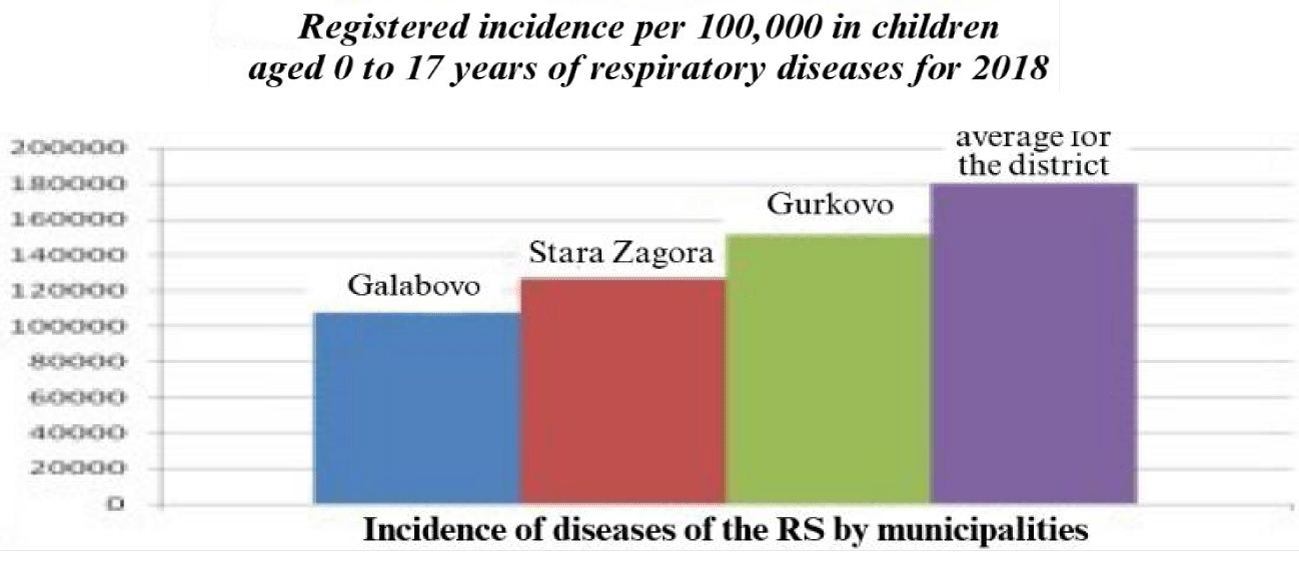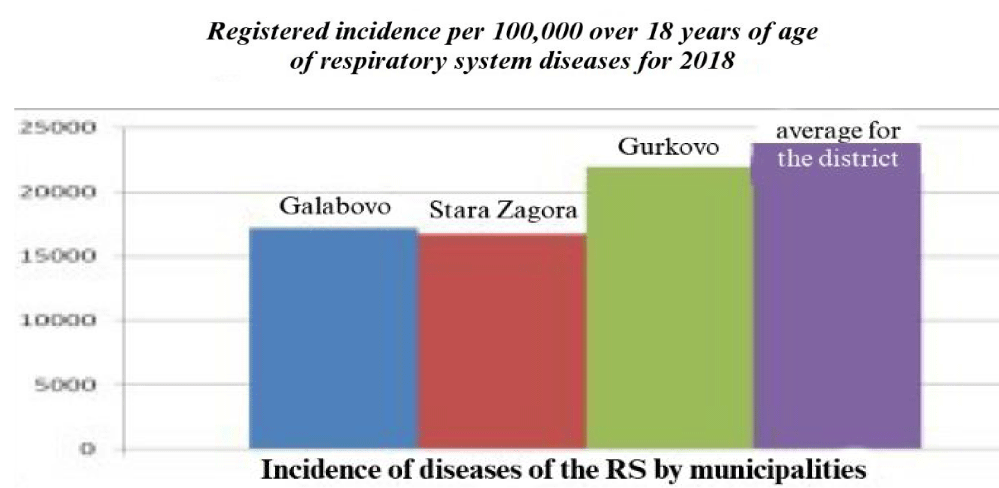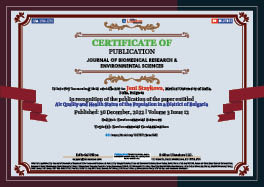Environmental Sciences . 2022 December 30;3(12):1541-1544. doi: 10.37871/jbres1632.
Air Quality and Health Status of the Population in a District of Bulgaria
Jeni Staykova1*, Juliya Dimitrova2 and Maria Titopoulou3
2MBAL-Pirdop, Bulgaria
3LOT-CONSULT, Sofia, Bulgaria
- Atmospheric air
- Excessive concentrations
- Morbidity
- Respiratory system
Abstract
The problems related to the environmental pollution caused by anthropogenic activity are particularly significant worldwide. The aim of the study is the quality of the atmospheric air in the region of Stara Zagora, Kazanluk Municipality and Galabovo Municipality and the morbidity of the population. The data are provided by RHI (Regional Health Inspectorate), RHIF (Regional Health Insurance Fund) and MI (Medical Institutions) Stara Zagora for a two-year period 2017-2018. Documentary, statistical and sociological methods are applied. For the period 2017-2018, in Stara Zagora, Ruzhena and Galabovo are reported excessive concentrations of PM10 (fine dust particles). There is an increase in the number of respiratory diseases with the highest relative share of acute bronchitis and pneumonia, especially in children. In order to reduce atmospheric air pollution and the health consequences for the population, it is necessary to carry out architectural and technological measures in the harmful productions of enterprises by installing modern purification facilities. Infrastructural measures such as improving the road surface and using ring roads are also needed.
Introduction
In recent years, environmental pollution has increased particularly intensively, which has led to adverse consequences for the health of the population. In international practice, the term "Environmental Disease" is officially recognized. It refers to any disease arising directly or indirectly, in whole or in part, as a result of the environment on the person [1-3]. Studies related to atmospheric air pollution in populated areas show its correlation with diseases that are provoked by the impact of the environment on humans [2-6].
The purpose of the study is to establish the relationship between the quality of atmospheric air and the health status of the population in three regions of Bulgaria/Stara Zagora region, Kazanlak Municipality and Galabovo Municipality/for the period 2017-2018.
Materials and Methods
The data for the survey were taken from the Regional Health Inspectorate - Stara Zagora. Morbidity of the population is provided by the Stara Zagora Hospital and the Annual Reports of the medical facilities in the district. Documentary, statistical and sociological methods were applied in the study.
For the control of atmospheric air quality, three automatic monitoring points are located on the territory of the Stara Zagora region, which are part of the National Environmental Monitoring System. Controlled indicators are: Аutomatic measuring station (AMS) Stara Zagora-FDP10, SO2, NO2, CO, O3, NO, H2S; methane and non-methane hydrocarbons; Manual, Stara Zagora (Regional Environment and Water Inspection)-fine dust particles lower than 2.5 micron (FDP2.5) and benzene; OPSIS village of Razena-FDP10, SO2, NO2, NO, heavy metals, HCl, Cl, HCN, phosgene; AIS, Galabovo - SO2, NO, NO2; Manual, town of Galabovo (“Galabovo”)-FDP10; Mobile Automatic Station (MAS)-fine dust particles lower than 10 micron, SO2, NO2, NO, CO, O3, dust, hydrocarbons (methane and non-methane) and six meteorological parameters-wind speed and direction, temperature, pressure, sunshine, humidity [7-9]. The general morbidity and mainly diseases of the respiratory system (according to ICD) of the population, provoked by atmospheric air pollution, were analyzed.
Results and Discussion
In 2018, the average annual norm of 40 μg/m3 according to the FDP10 indicator was not exceeded in the monitoring points on the territory of Regional Environment and Water Inspection (REWI)-Stara Zagora. In the Ruzhena station, there were no exceedances of the average annual norms (AAN) for Pb, Ni, Cd and As in 2018. The average annual norm for benzo/a/pyrene (surface active substances) of 1.32 mg/m3 was exceeded, but it was less than the measured concentration in 2017 from 1.58 mg/m3 at a norm of 1 mg/m3 for benzo/a/pyrene (surfactants). The average annual norms for the benzene indicator were not exceeded in 2018 at the manual sampling point of REWI-Stara Zagora. Compared to the values recorded in 2017, the results for 2018 show no significant change [6,7].
In an annual aspect, the limited number of exceedances according to the FDP10 indicator is 35, according to Ordinance No. 12 of 15.07.2010 for standards for SO2, NO2, fine dust particles, Pb, benzene, CO and O3 in atmospheric air. For 2018, this number was not exceeded in the monitoring points on the territory of the REWI - Stara Zagora. Compliance with the norms for fine dust particles lower than 10 micron /FDP10/ with the permitted number of exceedances in an annual aspect has been achieved in the municipalities of Stara Zagora and Galabovo. For the Automatic Measurement Station (AMS) Stara Zagora in 2018, there were 6 exceedances of the average day-night norm according to the FDP10 indicator, compared to 2017. There is a tendency towards a qualitative and sustainable improvement of the atmospheric air in the city of Stara Zagora. OPSIS village of Ruzhena - the number of registered exceedances of the average day-night norm of vehicles according to the FDP10 indicator in 2018 was 29. Compared to 2017, when the registered excesses were 5, in an annual aspect there is an increase in pollution according to this indicator.
For the region at the manual checkpoint Galabovo, in 2017, 26 excessive concentrations of average daily norms according to the FPC10 indicator were registered, and in 2018 there were 12, the average hourly norm at the same station was exceeded 72 times, and average day-and-night norm - 7 times. For comparison, in 2017, the average hour norm was exceeded by 117 times, and the limit value of the average day-and-night norm was exceeded 15 times. (Figures 1A,B).
As a result of atmospheric pollution, mainly with FDP, there is an increase in the number of diseases of the respiratory system, with the largest relative share of acute bronchitis and pneumonia. The most sensitive groups of the population - children, the elderly and people with chronic diseases - are also exposed to the potentially harmful effect of atmospheric pollutants.
The main air pollutants in the Stara Zagora region are sulfur dioxide and fine dust particles. With their combination, especially during the heating season, children and patients with bronchial asthma and other chronic lung diseases suffer. People with asthma are 10 times more sensitive to SO2 than healthy people. Children with asthma are particularly sensitive. Dust enters the body through the respiratory system, where larger particles are retained in the upper respiratory tract, and finer particles (lower than 10 nm-FDP10, FDP2.5) reach the lower parts of the respiratory system, leading to damage of the tissues in the lung, through mechanical irritation, microbial and toxic effect. Children, the elderly, and people with chronic lung disease, influenza, or asthma are particularly sensitive to high levels of FDP with prolonged exposure.
Prolonged exposure to SO2 and dust is manifested by an increase in non-specific lung diseases, mainly respiratory infections of the upper respiratory tract and bronchitis, at significantly lower concentrations of 30 ÷ 150 μg/m3, which is particularly strongly manifested in children.
The total morbidity registered by the population's referral for medical assistance to General Practitioners (GPs) in 2018 on the territory of Stara Zagora region is 123390.42‰ (390 353 cases) [2,6,7,10,11]. Morbidity in children from 0 to 17 years is 85400.16‰ and is higher compared to the population over 18 years-44 896.86‰. In the structure of general morbidity in the Stara Zagora region, diseases of the circulatory system (23.95% of all diseases) have the highest relative share, followed by diseases of the respiratory system (23.82% of all diseases).
In children, the structure of morbidity is dominated by respiratory pathology. Out of all registered diseases from primary care in 2018 in the territory of Stara Zagora region, in the age group from 0 to 17 years, the diseases of the respiratory system have the largest relative share-57.32%. For children up to 1 year, this share is 59.31%. Newly discovered diseases of the respiratory system in children from 0 to 17 years are 63.9% of their total number. The relative share of diseases of the respiratory system from the total number of registered diseases from primary care in 2018 on the territory of the Stara Zagora region among persons over the age of 18 is 15.93% and is second in frequency of distribution after diseases of the circulatory organs.
The structure of hospitalizations by classes of diseases and nosological units shows that among persons over 18 years of age, diseases of the circulatory system are the most common at 18.94%, followed by diseases of the digestive system at 12.17%. In persons from 0 to 17 years of age, diseases of the respiratory system are the most common - 44.78%, and 68.8% of hospitalizations in this class are cases of bacterial infections.
Therefore, we report an age gradient in respiratory morbidity. It is significantly more common in children from 0 to 17 years old and decreases in adults from the group over 18 years old, in which the diseases of the circulatory organs are in the first place in the morbidity structure. In children up to 17 years of age, the incidence of diseases of the respiratory system is 151561.18 ‰ and is also below and close to the average for the district. In the structure of respiratory pathology in children, acute infections of the upper respiratory tract have the largest relative share - 69.5%. The relative share of pneumonia is 9.4%, and of bronchial asthma 3.4%.
Registered incidence per 100,000 in children aged 0 to 17 years of respiratory diseases for 2018 (Figure 2).
Registered incidence per 100,000 over 18 years of age of respiratory system diseases for 2018 (Figure 3).
The main conclusions from the examination of the diseases of the respiratory system by nosological units shows that in children from 0 to 17 years of age with the largest relative share are acute upper respiratory tract infections, in all considered municipalities and in the district as a whole, both in the total number of cases and in those newly discovered in 2018. A similar dependence is observed in the population over 18 years of age.
The relative share of diseases of the respiratory system in the municipality of Gurkovo is lower than the average for the district, than Galabovo and Stara Zagora. In the population over 18 years of age, acute bronchitis and bronchiolitis are also in second place as a relative share of respiratory system diseases for the municipality of Stara Zagora, Galabovo and for the district as a whole, in third place in all three municipalities and the district are chronic diseases of the lower respiratory tract.
Conclusion
The main air pollutants in the Stara Zagora region are sulfur dioxide, general dust and fine dust particles (FDP10). In 2017 more excessive concentrations of the main pollutants were measured, such as average hour norms, average daily norms and average annual norms.
From the general morbidity of the population, the frequency of "Diseases of the respiratory system" is the highest, both among children and among adults in the towns of Stara Zagora, Galabovo and Gurkovo. Acute upper respiratory tract infections, bronchitis and pneumonia have the largest relative share. In 2018 certain results have been achieved to improve the quality of the atmospheric air, through the programs for the assessment and management of the quality of the atmospheric air and the action plans for them by the municipality of Stara Zagora.
In order to optimize the living environment, complex multi-sectoral measures by the interested institutions are necessary.
References
- Staykova J. Contemporary hygienic-ecological problems, UI St. Kliment Ohridski. Sofia. 2018.
- Antova T, Nikiforov B, Lolova D. Health risk of the population exposed to PM 10 and PM 2.5. Hygiene and Health care. 2001;53-56.
- Staykova J, Boyadzhiev VL, Lyapina M. Environmental pollution in industrial areas in Bulgaria. Metal Mining Industry. In: Hygiene and Ecology. Tsvetkov D, Kameya OOD, editors. Sofia: 2014. p.136-140.
- Basmadzhieva K. Hygienic-toxicological problems of atmospheric pollution and its influence on the health of the population. Doctoral Dissertation. 1985.
- Staykova J. Hygiene of atmospheric air. Atmospheric pollution In: Modern hygienic and ecological problems. UI St. Kliment Ohridski. Sofia. 2018. p.28-39.
- Staykova J. Ecological regulatory framework for environmental protection and management. In: Contemporary hygienic-ecological problems. UI St. Kliment Ohridski. Sofia. 2018. p.177-211.
- Gresiak P, Schroeder G, Hopke W. Degradasion of the natural environment resulting from the presence of sulphur compounds in the atmosphere. Polish Journal of Environmental Studies. 1997;6(4):45-48.
- Law on the Cleanliness of Atmospheric Air. 2019.
- Staykova J. Quality of the environment and health risk in the area of the city of Kardjali, UI St. Kliment Ohridski. Sofia. 2009.
- Tsvetkov D. Collective-Guide to Hygiene and Occupational Diseases. Sofia. 1994.
- Report on the quality of atmospheric air and the health status of the population in the region of Stara Zagora. 2016-2018.
Content Alerts
SignUp to our
Content alerts.
 This work is licensed under a Creative Commons Attribution 4.0 International License.
This work is licensed under a Creative Commons Attribution 4.0 International License.











